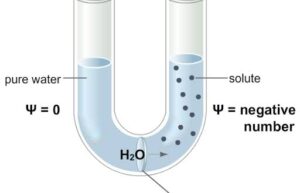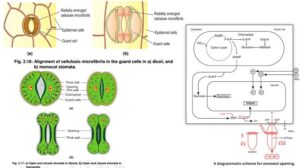Back to: Botany 400 Level
My brilliant Afrilearn scholar, welcome back! I hope you’re having a great day! Have you ever wondered how water moves from the soil into a plant’s roots, up the stem, and finally to the leaves? How does a tall tree like an iroko or mango tree pull water from the ground without a pump? The secret lies in some fascinating natural processes. Today, we’re learning about the Mechanisms of Water Absorption and Movement in Plants. By the end of this lesson, you’ll understand how water enters, moves through, and exits a plant.
Mechanisms of water absorption and movement (osmosis, diffusion, transpiration)
Imagine fetching water from a well using a rope and bucket. You dip the bucket into the well (just like roots absorb water), pull it up (just like water moves through the stem), and pour it into a container (just like water reaching the leaves). This is similar to how plants transport water, but instead of a rope, they use osmosis, diffusion, and transpiration.
Plants don’t have pumps, yet water moves from the roots to the leaves. This happens due to a combination of natural forces that ensure plants get the water they need to survive.

Mechanisms of Water Absorption and Movement
1. Osmosis (Water Absorption in Roots)
Osmosis is the movement of water from a region of high water potential (in the soil) to a region of low water potential (inside root cells) through a semi-permeable membrane.
The root hair cells have more solutes than the surrounding soil water, so water moves into the root by osmosis.
This process continues, allowing water to pass from cell to cell until it reaches the xylem (the plant’s water transport tissue).
Example:
If you soak dry garri in water, it swells because water moves into it by osmosis—just like how plant roots absorb water from the soil.
2. Diffusion (Short-Distance Water Movement in Cells)
Diffusion is the movement of water molecules from a region of high concentration to a region of low concentration, without needing a membrane.
Water moves from cell to cell within the root and stem using diffusion, ensuring all parts get hydrated.
Example:
If you drop a cube of sugar in a cup of water, the sugar spreads throughout the water without stirring. This is diffusion! Similarly, water moves inside plant tissues.
3. Transpiration (Water Movement from Leaves into the Air)
Transpiration is the loss of water as vapour from plant leaves, mainly through tiny openings called stomata.
As water evaporates from the leaves, it creates a pull (called the transpiration pull) that draws water up from the roots.
This process also helps to cool the plant and transport nutrients.
Example:
On a hot day, you sweat to cool down. Similarly, plants release water through transpiration to regulate their temperature.
Pathways of Water Movement in Plants
Once water is absorbed by the roots, it can move upward through two pathways:
Apoplast Pathway (Fast Route)
Water moves around the cells through the cell walls.
This pathway is quicker because water does not pass through cell membranes.
Symplast Pathway (Slow Route)
Water moves through the cells by passing from one cell to another through plasmodesmata (tiny openings between cells).
This pathway is slower but ensures better control over water movement.

Think about a maize farmer during the dry season. If the soil becomes dry, the water potential outside the roots decreases, making osmosis slow. The maize leaves may start curling up to reduce transpiration. But once rain falls, osmosis starts again, water moves through diffusion, and the leaves open up as transpiration resumes.
Another example is placing a fresh leaf under the sun. After some time, you’ll notice it shrinks. This is due to water loss through transpiration. But if you place the same leaf in water, it absorbs water again through osmosis and becomes fresh!
Summary
Plants absorb and move water using three key processes:
Osmosis: Water moves from the soil into the roots.
Diffusion: Water moves from cell to cell inside the plant.
Transpiration: Water evaporates from leaves, creating a pull that draws water up from the roots.
Water moves inside plants through the apoplast pathway (around cells) or the symplast pathway (through cells). These processes ensure that plants receive the water they need to grow, stay firm, and make food through photosynthesis.
Evaluation
- How does osmosis help plants absorb water?
- What is transpiration, and why is it important?
- Explain the difference between the apoplast and symplast pathways.
- How does diffusion help in water movement inside plants?
Keep learning, my scholar! Every new concept you understand is a step closer to mastering plant physiology. Water is life, and now you know how plants use it! Keep believing in yourself, and I’ll see you in the next lesson. Keep shining!
